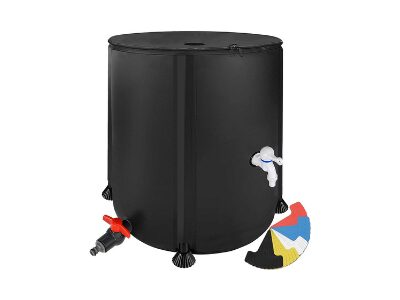
In your part of the world, if rain is scarce or you want to do what you can to save water, a rain barrel is a perfect addition to your house. Rainwater collection will send you gallons of free water you can use to wash your vehicle, water your garden, and more.
The first thing you have to do if you’re considering adding a rain barrel to your home is to make sure it’s allowed where you live. Some municipalities ban rain barrels, so testing before investing in time and materials is critical.
You will need to know the materials that make up your roof. It’s probably secure if you have a newer house. That said, the water may be polluted by certain roofing materials, thereby rendering it hazardous to use. A rain barrel would not be safe if your roof uses tar, dirt, or treated cedar or your gutters use lead paint. Make sure you find this out before you get started.
Also, See The 10 Best Garden Hose and Buyers Guide
What’s a Rain Barrel?
A rain barrel is a container that collects runoff from the gutter system of your house, which connects with a rain diverter to the downspout or fits under a modified downspout. A spigot or hose adapter allows the water to be drained across your landscape for use. Rainwater harvesting offers an alternative to the irrigation usage of urban water or well water. Water that is free of additives and minerals in tap water helps plants. The amount of runoff entering the storm sewer, holding pesticides, fertilizers, and other contaminants out of surrounding bodies of water, can be minimized by rain barrels. It also stops it from flooding your foundation, crawlspace, or basement by storing rainwater for later use. As a complement to municipal water, several cities offer financial incentives to use rainwater for irrigation.
Why Use Rain Barrels?
- Rain barrels help lower the cost of water. (In the course of a rain barrel, roughly 1,300 gallons of water can be saved during Summer’s peak months). Storing rainwater for garden and lawn use helps recharge groundwater naturally
- Via minimizing stormwater runoff, rain barrels minimize water pollution, Pollutants such as sediment, oil, grease, bacteria, and nutrients may be stored.
- It’s inexpensive and quick to build and install rain barrels.
Now, let’s take a look at how to get a rain barrel built and used.
Prep and Supplies
You may purchase a package of rain barrels or build one of your own. Start with a 55-gallon barrel, if you want to make your own. To stop any more contamination, make sure that it’s made of food-grade plastic.
First, decide your rain barrel’s best location. Most people put them in the gutters underneath the downspout. In a location near to where you want to use the water, it is also best to position it. For starters, if you intend to use it to wash your vehicle, try to position it near your driveway.
You have to make sure that the barrel has ample protection, too. As this makes it easier for the water to drain out later, most people prefer an elevated floor.
Making the Rain Barrel
The next step is putting the barrel on its side and using a one-inch drill bit to make a hole in the side of the barrel if you’re making your own rain barrel. For overflow, this hole should be located about three inches below the top edge of the barrel.
Next, for the spigot, drill a second hole about five inches above the barrel base. Through this opening, insert the spigot or a hose. Next, on the outside and inside of the opening, put rubber washers and sealant to ensure it stays watertight.
Repeat this step at the top of the barrel, to the overflow hole. Some individuals choose to tie the overflow to a hose because this helps you to direct the runoff to a suitable position in your yard. A second rain barrel can also be installed and you can guide the runoff hose into the second barrel to fill it.
You don’t have as much work to do if you purchase a rain barrel package. The holes are already in place, and any connectors that you need should be included in the package. If not, to make installation simpler, the company that made the rain barrel should offer optional accessories.
Also, See The Best 10 Garden Sprayers to Buy
How to Install a Rain Barrel
Did you pick up the barrels? If so, congratulations on taking action to help with climate change and drought! To learn how to mount your barrels, follow our simple setup instructions below.
Step 1: Choose where to place your barrel
Look for areas where your gutters fill with water which can be diverted to your garden.
Step 2: Make sure to place your barrel on a raised surface
Once you have selected the best position for your barrel, it will need to be mounted approximately 12 to 15 inches off the ground on a raised surface.
- As a solid and robust foundation, cinderblocks and 18″ square pavers fit really well.
- To prepare the ground and to align the foundation, use a level. This will guarantee that the barrel will be stable.
- Put one paver down and place the two blocks of cinder on top (on their sides and beside each other). Then place the second paver to create a “sandwich” on top of the cinder blocks. Then, on top, but the rain barrel.
Step 3: Install the downspout
It’s possible that your downspout will need to be shortened and add bits or elbows.
Make use of a hacksaw where your downspout needs to be shortened and cut as desired.
Over the downspout, attach the elbow(s).
Step 4: Do a test run
- To search for any problems, run some water through your gutters with a hose into the rain tank.
- Secure the rain barrel and secure it to the building with metal/all-weather earthquake braces.
How to Use Rainwater?
Know that, before settling in the barrel, rainwater flows over your roof and into the drainpipe. Unless you handle it first, it sucks up a lot of chemicals, toxins, and bacteria and is not safe to drink.
A rain barrel can gather a lot of water during an inch of rainfall. All in all, you’ll get a roof size of around half a gallon per square foot. There are many ways to use rainwater, such as washing the vehicle, cleaning the furniture on the porch or pool toys, or watering the trees, lawn, or garden.
If you want to water a vegetable garden using rainwater, make sure it gets into the soil and avoid directly spraying it on the crops and plants.
Keep in mind, this water is not quite the same as rainwater as it was on your roof, through the gutters, and sitting in the barrel, so you need to take some extra precautions. Only to be on the safe side, wash the vegetables well in the sink before feeding.
Also, See The 10 Best Electric Leaf Blower for Cleaning Your Lawn and Garden






